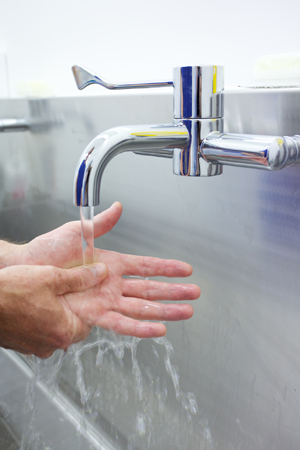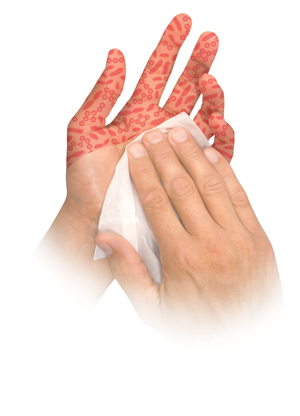Hand Hygiene: Necessary but Not Sufficient
July / August 2012
![]()
Hand Hygiene: Necessary but Not Sufficient
 Common sense, at least since Antonie van Leeuwenhoek in 1676 and Louis Pasteur in 1862, has dictated that we should be cautious of germs. Leeuwenhoek is credited with being the first microbiologist and Pasteur with developing germ theory in his work in the same field.
Common sense, at least since Antonie van Leeuwenhoek in 1676 and Louis Pasteur in 1862, has dictated that we should be cautious of germs. Leeuwenhoek is credited with being the first microbiologist and Pasteur with developing germ theory in his work in the same field.
Today, everyone in the hospital—where patients are weakened and more susceptible to HAI (hospital-acquired infection)—is admonished to avoid contact with germ-contaminated surfaces. A direct codicil to that is to maintain unconditional hand hygiene while around patients.
The problem is, there are so many sources of contamination in and around the care unit that barring “clean room” status—an ISO 1 clean room allows only 12 particles of 0.3 micrometer and smaller per cubic meter of air—eliminating germs and other contaminants is virtually impossible. Everything, every surface including the patient’s skin, potentially fosters undesirable biological elements. What needs to be done is limit the transfer of those agents from one area to another.
A modern-day microbiologist known as The Germ Guy in his public presentations, Jason Tetro is coordinator for the Emerging Pathogen Research Centre (EPRC) and the Centre for Research on Environmental Microbiology (CREM) both at the University of Ottawa. He comments,
The medical idea, ‘First, do no harm’ (Primum non nocere) has both direct and indirect aspects. Healthcare professionals are trained to directly cause no harm. The indirect way of do no harm is something that’s a little more abstract and I think is a little bit more touch-and-go when it comes to healthcare professionals. Realistically, the indirect ways of causing no harm include not transferring germs from one patient to another.
But there is more to be concerned about than transfer by touching. Tetro explains,
It can also include putting an immune-compromised patient directly underneath an air vent, and that air vent is connected to a TB or SARS ward, as we found in Hong Kong back in 2003. Those are some of the indirect means by which healthcare professionals can do no harm, by following procedures that, while they may seem innocuous, actually are going to help prevent harm to the patient.
Workplace Environment
A recent report from The Healthy Workplace Project, sponsored by Kimberly-Clark Professional (www.healthyworkplaceproject.com), examined the presence of contamination upon surfaces in typical work environments. Using an adenosine triphosphate (ATP) level of 300 or greater as a benchmark for high contamination, they found common surfaces touched by everyone exhibit potentially dangerous levels of biological contamination.
ATP monitoring, as done in the Healthy Workplace Project, uses a quick test unit to determine the level of ATP, an enzyme that is present in all living cells. An ATP monitoring system can detect the amount of organic matter that remains after cleaning an environmental surface, a medical device, or a surgical instrument.
Hospitals are using ATP-based sanitation monitoring systems to detect and measure ATP on surfaces as a method of ensuring the effectiveness of their facilities’ sanitation efforts. The amount of ATP detected, and where this ATP was detected, indicates areas and items in the healthcare setting that may need to be cleaned again and the possible need for improvement in a healthcare facility’s cleaning protocols.
Consulting on the project was Dr. Charles Gerba, microbiologist and professor at the University of Arizona, Tucson. “We found that typically, hospital environments are better than offices, but common elements in both are suspect. Hospitals are getting pretty good with computer keyboards by using the ones that have plastic covers or that are washable, but they forget the touch screen. They were pretty bad, far worse than the keyboards because nobody really was doing anything about cleaning the touch screens.”
As would be expected—and hoped for—touch screens in the hospital are still much better than those in public areas. “We didn’t find any MRSA or C-difficile, (Clostridium difficile) at the hospital; we found it on the touch screens in grocery stores,” Gerba says.
“I can tell you where you get the most E. coli on your hands,” he adds, “and that’s if you make a meal in a break room and you handle meat products or microwave something and then handle a sponge or a dishcloth. They have them there to wipe out your coffee cups and E. coli grows on those things and so do coli-form bacteria and a lot of other opportunistic pathogens. Everything may be fine in the patient area, where a lot of due diligence is paid, but when you go to that break room it gets pretty bad, particularly the sink area and the microwave door handle.”
In some facilities, the break rooms are cleaned and serviced by the general cleaning staff while at other hospitals the food service people do it. The latter may not go into the general patient area—food carts are delivered by other staff members—so they may be less concerned about hand hygiene. However, they are transfer agents, bringing contaminants from one area of the facility to the break room where they can be picked up by the unit nursing and medical staff.
“We watched people in break rooms,” Gerba recalls, “and they touch as many as 30 objects in about 3 or 4 minutes. What we see when we do a contamination event, everything ends up first in the break room and then it moves out to the work areas. So, the break room may have been overlooked a bit because it’s not considered the main work environment.”
An interesting dichotomy is that the easier a surface is to clean, the more likely you will take contaminates from it. Gerba claims “about 50 to 60% of the bacteria or virus on a stainless steel surface will be picked up by your hand when you touch it.” Contrary to common belief, one of the hardest things to get any bacteria off is money.
Automated Compliance Monitoring
To prevent the transfer from the break room or anywhere else to the patient, hand hygiene compliance is critical. There have been ways developed that can increase awareness and compliance, among them one called Hospital Watch Live.
Designed to assist hospitals in controlling and stopping the spread of infectious organisms, Hospital Watch Live has been installed at Toronto General Hospital on the multi-organ transplant unit, an area of the hospital where all of the patients are on therapies to prevent organ rejection, which also suppresses their immune systems.
Hospital Watch Live follows and records—in real time—the movement, contact, and interaction of patients, employees, and equipment. The system relies on ultrasound devices located throughout the facility. At admission, organ-transplant patients will receive miniature badges attached to their wristbands; doctors will pin them to their shirts; and they’ll be attached to hundreds of pieces of equipment ranging from wheelchairs to bedpans. Larger sensors are mounted on the walls, and ceilings are equipped with microphones that record information and feed it into an interactive database that can be accessed by staff through the hospital’s internal network.
The system was developed by Infonaut, Toronto. CEO Niall Wallace started the company after watching Ontario’s response to the 2003 SARS outbreak. “At that time there was really no surveillance available, and it was tough to get a handle on what was happening,” he says. “You can’t understand disease without understanding where things are traveling.”
The equipment is sensitive enough that it can recognize when physicians are facing a patient, when they turn their backs, and when they step out of the room. It also picks up when staff members should wash their hands (every time they step out of the patient environment) and records whether or not that’s done.
 Michael Gardam, director of infection prevention and control at the University Health Network, worked on the project. “There are a lot of controversies around hand hygiene and how we know that people are doing what they’re supposed to do. Currently, the gold standard is direct observation, where you have somebody literally with a clipboard or an iPad who’s watching you as you go about your daily work, checking off whether or not you cleaned your hands at the right time. The idea of Hospital Watch Live is that it’s essentially automating hand hygiene compliance monitoring.”
Michael Gardam, director of infection prevention and control at the University Health Network, worked on the project. “There are a lot of controversies around hand hygiene and how we know that people are doing what they’re supposed to do. Currently, the gold standard is direct observation, where you have somebody literally with a clipboard or an iPad who’s watching you as you go about your daily work, checking off whether or not you cleaned your hands at the right time. The idea of Hospital Watch Live is that it’s essentially automating hand hygiene compliance monitoring.”
The system works with staff and patient badges, gel and soap dispensers connected to the network. “If I’m wearing one of these badges, it knows that I’ve walked into that room,” claims Gardam. “It knows whether I have pumped the alcohol gel or not, and it knows whether I am coming up to the patient and standing there–presumably touching the patient. If there are two patients in a room, it’ll know what direction I’m facing and it’ll know what patient I’m going to.”
It doesn’t really matter whether the patient is walking down the hallway or sitting in their room. The system can determine when staff and patient are in the same space and when the caregiver is in proximity to the hand hygiene station.
Hospital Watch Live is also linked with pieces of equipment—for example the bed, the mattress, large pieces of equipment that are going room to room, etc. “If there’s a case of a particularly communicable disease that pops up,” explains Gardam, “you can do contact tracing to figure out not only which patients a person has been in contact with or what room, but also what mattress, what bed, what other large pieces of equipment. We often wonder in infection control, when patients develop C. difficile, could they have caught it from a healthcare worker’s hands or potentially caught it from the mattress they’re on. Maybe part of it wasn’t properly cleaned. If we know that mattress had previously been in contact with a patient with C. difficile, that can give you a lot of information.”
Gardam quickly adds, “Don’t get me wrong, hand hygiene is incredibly important, but you can’t just do that. There are many ways that these things spread in hospitals that doesn’t actually involve healthcare worker hands, so it’s one of those things where it’s necessary but not sufficient. Something like ATP monitoring is a really helpful way of showing where live organisms are, so even though you thought you disinfected it, there are still problems.”
Monitoring the patient’s environment, medical and staff hand hygiene events, the equipment and housekeeping in the patient’s room and elsewhere on the floor is being automated more and more. Even so, the protocols and policies of the facility will be what drives increased awareness and caution in hand hygiene. Making it happen is still a human project.
Tom Inglesby is an author based in southern California who writes frequently about medical technologies and improvement strategies.
